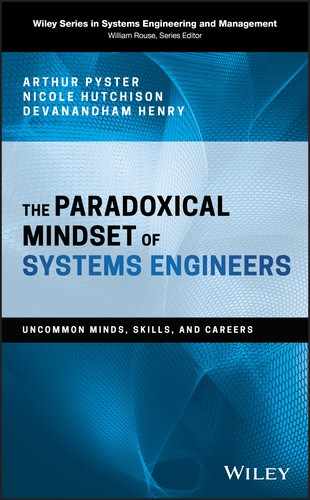ABOUT THE AUTHORS
Dr. Arthur (Art) Pyster has more than 40 years of experience as a researcher, engineer, educator, executive, and manager in government, industry, and academia. He has been involved with leading‐edge systems and technologies in telecommunications, aerospace, defense, air traffic control, and information technology domains and has led software and systems engineering workforce development efforts in both industry and government. Currently, he is the Associate Dean for Research in George Mason University’s Volgenau School of Engineering, where he is also a Professor of Systems Engineering. In his previous position, he was a Distinguished Research Professor in the School of Systems and Enterprises at Stevens Institute of Technology, the Chief Operating Officer of the Systems Engineering Research Center, and the Director for Academic Matters for the International Council on Systems Engineering (INCOSE). Among his earlier positions, he was the Senior Vice President and Director of Systems Engineering and Integration for SAIC and the Deputy Chief Information Officer and Chief Scientist for Software Engineering at the US Federal Aviation Administration. He is an INCOSE Fellow, a member of the INCOSE Board of Directors, and a recipient of the INCOSE Founders Award.
Dr. Nicole Hutchison has been involved in all the foundational research that provides the basis for this book. She has personally helped collect a majority of the data and conducted substantial analyses into skills, career paths, and personal enabling characteristics of systems engineers. The work focused around career paths formed the basis of her dissertation. She has 11 years of analytic and systems engineering experience. At Stevens, she has also conducted research on technical leadership and mission engineering. In addition, she was the primary architect and manager of the Systems Engineering Body of Knowledge (SEBoK) wiki through 2014, work that she has recently started supporting again. Prior to joining Stevens, she supported many branches of the federal government, including the Departments of Defense, Homeland Security, and Health and Human Services through her prior employment at ANSER in Virginia. She is a Certified Systems Engineering Professional (CSEP) with roughly two dozen publications on systems engineering.
Dr. Devanandham (Deva) Henry is an assistant professor at Regent University in Virginia Beach, Virginia, where he leads the systems engineering program. Previously, he was a research engineer with the Systems Engineering Research Center (SERC) at Stevens Institute of Technology. He has supported the development of Systems Readiness Levels, the Graduate Software Engineering Reference Curriculum, the SEBoK, and the Graduate Reference Curriculum for Systems Engineering (GRCSE). He was a key member of the Helix project for several years. Before joining Stevens, he spent 9 years with the Aeronautical Development Agency, Ministry of Defense, India, working on aircraft design, aerodynamics, performance, optimization, and project management of the Air Force and Navy versions of the Indian light combat aircraft. He was also actively involved in promoting systems engineering among the aerospace community in India.
The three authors exemplify the fact that people with diverse education can all end up as systems engineers. Pyster’s three degrees are in mathematics and in computer and information sciences. Typical of the time, he had never even heard of systems engineering when he started as a professor at the University of California at Santa Barbara in 1976. Hutchison has a very diverse education. She earned two bachelor’s degrees – one in classical studies with a Latin minor and the other in biology. She has a master’s degree in biohazard threat agents and emerging infectious disease. She earned her doctorate in systems engineering from Stevens Institute of Technology. Finally, Henry also has two bachelor’s degrees – the first in physics from the University of Madras in India and another in aeronautical engineering from Anna University, also in India. He also holds a master’s degree in aerospace systems engineering from IIT Bombay in India and a PhD in systems engineering from Stevens Institute of Technology.
The three authors have a combined 11 university degrees, 10 in Science, Technology, Engineering, and Math (STEM) fields. Pyster has no classic engineering degree (such as electrical, mechanical, or civil) at all, coming to systems engineering first through computer science and then through software engineering. Hutchison has no classic engineering bachelor’s degree but has a PhD in systems engineering. Finally, Henry has a classic bachelor’s and master’s engineering degree and a PhD in systems engineering. As you will discover in this book, the education of these three professionals follows a pattern practiced by many. Systems engineers who started their careers several decades ago rarely have a degree in systems engineering (Pyster). They largely learned systems engineering on the job. Systems engineers who entered the job market more recently often have a classic engineering or a science bachelor’s degree and a graduate degree in systems engineering (Hutchison and Henry).
